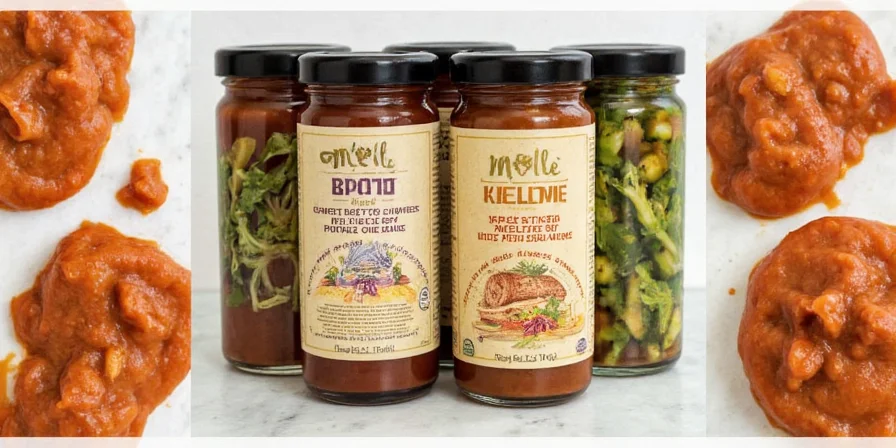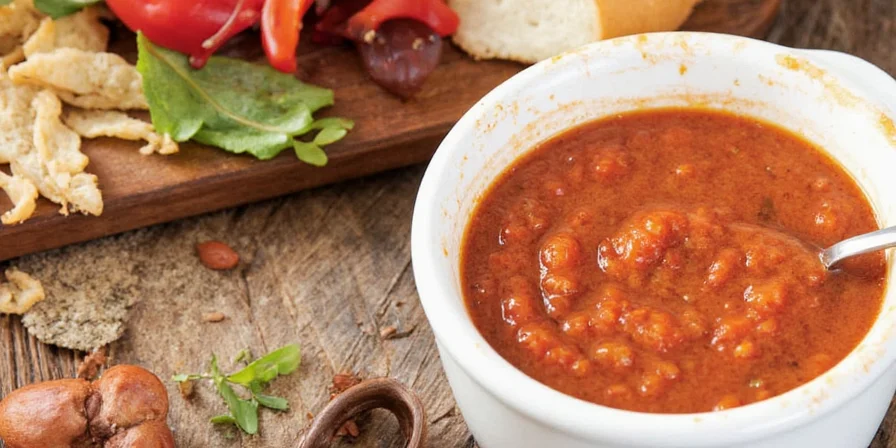Mole sauce (pronounced 'moh-lay') is a complex Mexican sauce made from 20+ ingredients including chilies, spices, nuts, seeds, and sometimes chocolate. Contrary to common misconceptions, authentic mole isn't simply a 'chocolate chili sauce' but rather Mexico's most sophisticated culinary achievement with regional variations developed over centuries.
If you're searching for a mole sauce recipe, here's what you need to know first: Authentic mole requires multiple preparation stages where ingredients are toasted, fried, and blended in specific sequences. Traditional mole poblano (the most famous variety) typically includes ancho, pasilla, and mulato chilies, sesame seeds, almonds, tomatoes, plantains, cinnamon, cloves, and Mexican chocolate. The entire process takes 3-6 hours, not minutes.
Below, you'll find:
- Authentic mole poblano recipe with precise ingredient measurements
- Step-by-step preparation guide for first-time makers
- Common mistakes that ruin homemade mole (and how to avoid them)
- Differences between regional varieties you can actually find
- How to identify truly authentic mole versus commercial shortcuts
Table of Contents
- What Is Mole Sauce? Definition and Quick Facts
- Authentic Mole Poblano Recipe (Step-by-Step)
- 5 Most Common Mole Mistakes and Fixes
- Regional Mole Varieties You Can Actually Find
- Mole Flavor Profile: What to Expect
- How to Use Mole Sauce Properly
- Homemade vs. Store-Bought Mole Paste
- Adjusting Heat Level Without Ruining Authenticity
- Mole vs. Other Sauces: Clear Differences
- Frequently Asked Questions
What Is Mole Sauce? Definition and Quick Facts
Mole sauce (not 'molle') is Mexico's national sauce with deep cultural roots, originating from pre-Hispanic Mesoamerica. The term comes from the Nahuatl word 'mōlli,' meaning 'sauce' or 'concoction.' Authentic mole contains 20-30 ingredients prepared through multiple stages of toasting and frying.

Key facts most people get wrong:
- Mole isn't primarily about chocolate - only specific varieties like mole negro contain it
- It's not extremely spicy - most traditional moles are mild to medium heat
- Mole and guacamole are completely different - 'guacamole' means 'avocado sauce' in Nahuatl
- Authentic mole takes hours to prepare, not minutes
Historical Context for Cooks
Mole's origins blend indigenous Mesoamerican ingredients with Spanish colonial additions. While mole poblano is often called Mexico's national dish, it reportedly originated in Puebla when nuns combined Old World and New World ingredients to honor a visiting archbishop. This historical fusion explains why authentic mole requires both native chilies and introduced ingredients like almonds and cinnamon.

Authentic Mole Poblano Recipe (Step-by-Step)
This traditional recipe serves 6 and takes approximately 4 hours. Don't skip the toasting/frying stages - they're essential for authentic flavor development.
| Ingredient | Measurement | Preparation Step |
|---|---|---|
| Dried chilies (ancho, pasilla, mulato) | 5 oz total (2 ancho, 2 pasilla, 2 mulato) | Toast dry in skillet 2 minutes per side until fragrant but not burnt |
| Tomatoes | 2 medium | Char directly over gas flame until blackened, then peel |
| Plantain | 1 small, ripe | Fry in oil until golden brown on both sides |
| Sesame seeds | 3 tbsp | Toast in dry skillet until golden |
| Mexican chocolate | 1 tablet (about 3 oz) | Add during final simmering stage |
| Chicken stock | 4 cups | Use homemade for best results |
Preparation Process
- Toasting stage: Toast each ingredient separately in a dry skillet (chilies first, then nuts/seeds, then spices)
- Frying stage: Fry tomatillos, tomatoes, and plantains in oil until softened
- Blending: Blend all toasted and fried ingredients with 1 cup stock until completely smooth
- Simmering: Cook blended mixture in remaining stock for 1.5-2 hours, stirring frequently
- Final touches: Add chocolate during last 30 minutes of cooking
Critical tip: Authentic mole should coat the back of a spoon but remain pourable. If too thick, add small amounts of stock. If too thin, continue simmering to reduce.

5 Most Common Mole Mistakes and Fixes
Even experienced cooks make these errors when preparing authentic mole:
- Mistake: Using chili powder instead of whole dried chilies Solution: Always start with whole dried chilies - ancho, pasilla, and mulato are essential for mole poblano
- Mistake: Adding chocolate too early in the process Solution: Add Mexican chocolate during the final 30 minutes of simmering
- Mistake: Skipping the toasting/frying stages Solution: Toast each ingredient separately before blending to develop layered flavors
- Mistake: Over-blending to a completely smooth consistency Solution: Traditional mole has subtle texture - strain through coarse mesh, not fine
- Mistake: Using generic 'mole paste' without adjustment Solution: If using commercial paste, enhance with fresh ingredients as described below
Regional Mole Varieties You Can Actually Find
Understanding these authentic varieties helps you select the right mole for your needs:
- Mole Poblano (Puebla): The most internationally recognized, featuring ancho/pasilla/mulato chilies with subtle chocolate notes - ideal for turkey or chicken
- Mole Negro (Oaxaca): The most complex variety with charred ingredients giving deep color - requires most preparation time
- Mole Coloradito (Oaxaca): A redder, slightly sweeter variation with less chocolate - good for beginners
- Mole Verde (Central Mexico): A fresh, herb-based mole without chocolate - ready in less time than traditional varieties
- Commercial 'mole' products: Most store-bought options are simplified versions of mole coloradito
When shopping for ingredients, look for regional specificity: authentic Oaxacan mole products will state 'Oaxaqueño' while Puebla varieties will reference 'poblano.'
Mole Flavor Profile: What to Expect
Authentic mole develops in distinct flavor stages:
- Initial impression: Earthy notes from toasted chilies (not overwhelming heat)
- Middle notes: Richness from nuts/seeds with subtle sweetness
- Developing complexity: Warm spices like cinnamon and cloves emerge
- Finishing notes: In chocolate-based moles, subtle bitterness balances other elements
Most traditional moles register between 500-2,500 Scoville units (mild to medium heat), significantly milder than many assume. The complexity comes from layered flavors, not intense spiciness.
How to Use Mole Sauce Properly
Traditional applications that honor cultural authenticity:
- Classic pairing: Mole poblano traditionally served with turkey (not chicken)
- Proper serving: Always serve hot but not boiling to preserve flavor complexity
- Essential accompaniments: White rice and warm corn tortillas (never flour tortillas)
- Garnish: Sprinkle with toasted sesame seeds just before serving
- Storage: Keeps 3-4 days refrigerated or 3 months frozen (flavors improve after 24 hours)
Modern Adaptations That Still Respect Tradition
- Use mole as a braising liquid for chicken thighs
- Thin with additional stock for enchilada sauce
- Drizzle over roasted vegetables for quick weeknight meal
- Use as a base for mole-topped tamales

Homemade vs. Store-Bought Mole Paste
Understanding the differences helps you make informed choices:
| Aspect | Authentic Homemade | Quality Commercial Paste | Low-Quality Commercial |
|---|---|---|---|
| Ingredient List | Whole ingredients, no preservatives | Identifiable whole ingredients | Vague 'spice blends', artificial flavors |
| Flavor Complexity | Multiple distinct flavor layers | Moderate complexity | One-note, primarily spicy |
| Texture | Subtle grain from proper straining | Smooth but with some texture | Completely homogenized |
| Preparation Time | 3-6 hours | 20-30 minutes | 5-10 minutes |
| Best For | Special occasions, cultural events | Weeknight meals with authenticity | Emergency quick meals |
Pro tip: Enhance commercial paste by toasting additional sesame seeds and blending with fresh tomatoes before incorporating the paste.

Adjusting Heat Level Without Ruining Authenticity
Traditional mole makers adjust heat through ingredient selection, not additives:
- Reduce heat: Increase proportion of ancho chilies (mild) while decreasing mulato (medium heat)
- Increase heat: Add small amount of chipotle or guajillo chili (never pure capsaicin)
- Brighten flavors: A splash of white vinegar balances heaviness without sugar
- Fix bitterness: Add small amount of ripe plantain or tomato (never sugar)
Why Authentic Mole Never Tastes 'Burnt'
Traditional preparation carefully controls charring levels. Properly charred ingredients contribute smoky depth without bitter notes. If your mole tastes burnt, ingredients were over-charred during preparation.
Mole vs. Other Sauces: Clear Differences
Understanding these distinctions prevents culinary confusion:
| Characteristic | Mole Poblano | Curry Sauce | Harissa |
|---|---|---|---|
| Primary Purpose | Flavor complexity and cultural expression | Spice delivery | Heat and garlic flavor |
| Preparation Method | Multiple toasting/frying stages | Dry or wet spice application | Simple paste blending |
| Heat Level | Mild to medium (500-2,500 Scoville) | Variable (1,000-100,000+) | Medium to high (5,000-50,000) |
| Key Ingredients | Dried chilies, nuts, seeds, spices, sometimes chocolate | Turmeric, cumin, coriander, ginger | Chilies, garlic, caraway, coriander |
| Traditional Application | Specific pairings (turkey) | Versatile across proteins | Marinades, stews, spreads |
Critical Distinction for Home Cooks
Unlike many global sauces that primarily deliver heat, authentic mole's purpose is flavor complexity. Calling mole 'Mexican hot sauce' fundamentally misunderstands its culinary significance.
Frequently Asked Questions
How long does homemade mole last?
Authentic mole keeps 3-4 days refrigerated or 3 months frozen. Unlike commercial versions with preservatives, traditional mole is best treated as fresh preparation. Flavors actually improve after 24 hours as complex elements meld together - this is why mole is often made a day before serving.
What's the biggest mistake beginners make with mole?
Oversimplifying it as merely a 'chocolate chili sauce' or trying to rush the preparation. Authentic mole requires multiple stages of toasting and frying - each ingredient must be prepared separately to develop layered flavors. The process cannot be shortcut without sacrificing authenticity.
Can mole be made gluten-free?
Traditional mole is naturally gluten-free as it contains no wheat products. Some commercial versions may include bread as a thickener, but authentic preparation uses tortillas, sesame seeds, or nuts instead. Always check ingredient labels if using commercial products.
Conclusion: Making Authentic Mole Accessible
Mole sauce represents Mexico's sophisticated culinary heritage, but you don't need to be an expert to prepare it authentically. By understanding the essential techniques - proper toasting of ingredients, correct sequence of preparation steps, and regional variations - home cooks can create genuinely authentic mole.
The key is respecting mole's complexity while making it approachable: start with mole coloradito (simpler preparation) before attempting mole negro, use quality commercial paste as a starting point if needed, and always prioritize proper technique over rushing the process.

When prepared with understanding and care, mole offers one of the world's most rewarding culinary experiences - complex yet balanced, traditional yet adaptable, challenging yet achievable for dedicated home cooks.











 浙公网安备
33010002000092号
浙公网安备
33010002000092号 浙B2-20120091-4
浙B2-20120091-4